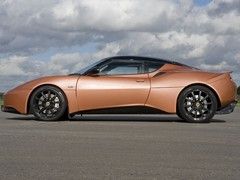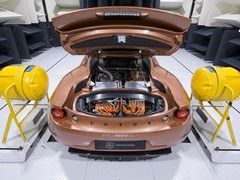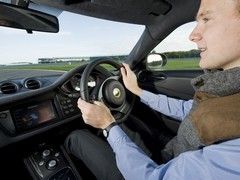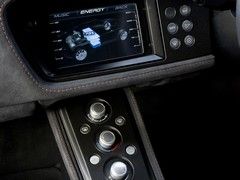Driven: Lotus Evora 414E
Lotus's range-extender Evora proves engineering cleverness is very much alive and kicking at Hethel

But there's another figure that is a cause of some concern, and that's the weight. Making an Evora S into an Evora 414E has added 377kg, making a total of 1,759kg.
Having said that, who better than Lotus to create a viable driver's machine with such an apparent disadvantage? For thoroughness, attention to detail and engineering alchemy, there's surely few better. With such an increase in mass, it was vitally important for Lotus to keep as much of it between the axles as possible. To that end, the battery pack sits where the rear seats would in an Evora 2+2 and the 1.2-litre engine sits comfortably ahead of the rear wheels. This has resulted in a weight distribution of 37:63 front to rear, which compares favourably to the 38:62 of an Evora S.
So much for the tech...
How does this translate out on the track? Impressively, in a word. As the 414E is currently a one-off prototype and we were only given four laps of a track there wasn't quite the opportunity to go in hard like Mr Harris did with the Exige S earlier in the year. Lack of familiarity with 'new' Hethel's layout didn't help either.
Down the straights though... In EV mode, which gives a range of 30 miles, the performance is not as strangled as you might expect. Crucially also, the accelerator pedal is fantastically weighted, meaning you can add more electric performance easily without causing the range extender and generator to chime in.
When you do ask the 414E for everything though, it responds instantly and ferociously. There is seemingly no delay between applying full throttle and deploying 414hp and 738lb ft to the tarmac, despite the fact that the range extender must start up and power the generator before the power is there. The surge, as you would expect, is hugely linear and apparently limitless, the Evora rushing though 100mph almost disdainfully.
Seamless
But, because of this seamless nature, the performance isn't that engaging. The three-cylinder engine is a bespoke range-extender, so it spins only between 1,500 and 3,500rpm. Whilst this is the optimum engine speed to power the generator, it means there is nothing by way of crescendo as you accelerate, as there would be in a conventional car. Moreover, the noise emitted isn't particularly emotive currently, a rather industrial drone overlaid with a little three-cylinder hum.
The rest of the driving experience feels as well calibrated as we expect of any Lotus, with plenty of poise and feedback through the wheel. Moreover, whilst the suspension is stiffened to cope with the extra weight, it is still tolerable around the track's bumpy entry roads. And whether you are lifting off at 100mph or 30, the regenerative braking gives the same response, noticeably aiding the braking process but with such nuanced precision to be easily adapted to after just a few minutes.
Shop window
The 414E shows that a range-extender hybrid drivetrain is a viable option for performance cars. With the REEVolution (get it?) still nascent, Lotus is promising (and will surely deliver) further advances in terms of noise with its HALOsonic technology and a simulated paddleshift also. PH will be outlining this and all the other tech that comprises the 414E package soon, so watch this space.
Finally, it is worth noting the Evora 414E is not intended as production concept; the car is a showcase for the technology developed as part of the tie-up, to display to the world that Lotus can develop hybrid powertrains. Now it hopes to outsource these skills, to profit from what they've learnt by installing the tech into the products of other manufacturers.
The 414E is far more than the sum of its statistics then. It shows Lotus is again at the vanguard of automotive innovation, delivering tangible advances before the competition. Interest in this project will only increase as it develops, which can only benefit Lotus further. No doubt it needs some good fortune right now, and the Evora Range Extender Electric Vehicle deserves to return Lotus to prominence.
LOTUS EVORA 414E
Engine: 1,198cc 3-cyl range extender, 2x electric motors
Transmission: Direct drive twin electric motors in rear wheels
Power (hp): 414hp (combined)
Torque (lb ft): 738lb ft (combined)
0-62mph: 4.4sec
Top speed: c. 133mph
Weight: 1,759kg
MPG: 45mpg (approx, with range-extender)
CO2: c. 55g/km (overall)
Price: Development prototype
Isn't it the lack of a gearbox? Electric motors provide huge torque at pull-away, and so don't need a gearbox for this.
But their top RPM is limited by the mechanics of spinning magnetic fields. Field weakening is used to overcome this, but then you lose torque....
The F1 era of performance through light weight used engineering to push the boundaries of what was possible, using technical excellence to achieve this. This car is exactly the same, only the boundaries are defined by more than just F1 regulations.
Personally, I think this is the short-term future of performance motoring. I'm just amazed it's taken so long to come about.
I'd guess the torque (1000Nm) and rpm (12k) of the electric motors would make it hard to find an off the shelf gearbox.

Driving the wheels of a vehicle directly from an internal combustion engine is completely and utterly stupid.
"The interior and exterior are both styled to reflect the battery powered nature of the car, with the copper colour resembling that of a battery, while the roof and engine cover are made of glass with electrical contact detailing."
Don't think the mule has the same detailing on the engine cover as the original concept show car, but that's where the colour comes from.
Gassing Station | General Gassing | Top of Page | What's New | My Stuff







